Find more information in the General Comments section of the assessment
Find more information in the Rating Validity tab of the assessment
- See More
- See More
- See More
- See More
- Good
- Adequate
- Marginal
- Weak
- Poor
 Passenger
Passenger
 Driver
Driver
 Rear Seat
Rear Seat
 Front Seat
Front Seat
 Car
Car
 Pole
Pole
- Good
- Adequate
- Marginal
- Weak
- Poor


Passenger
outboard
Fitted to the vehicle as standard
Not fitted to the test vehicle but available as option
Not Available
-
Infants up to 13 kg
-
Infants and toddlers up to 18 kg
-
Toddlers from 9 to 18 kg
-
Toddlers over 18 kg
Easy
Difficult
Safety critical
Not allowed
| Seat Position | |||
|---|---|---|---|
| Front | 2nd row | ||
| Passenger | Left | Right | |
| Maxi Cosi Cabriofix (Belt) | |||
| Britax Römer King Plus (Belt) | |||
| Britax Römer Duo Plus (ISOFIX) | |||
| Britax Römer KidFix (Belt) | |||
| Maxi Cosi Cabriofix & EasyFix (Belt) | |||
| Maxi Cosi Cabriofix & EasyFix (ISOFIX) | |||
| BeSafe iZi Kid X3 ISOfix (ISOFIX) | |||
| Maxi Cosi Pearl & Familyfix (ISOFIX) | |||
| Britax Römer KidFix (ISOFIX) | |||
Easy
Difficult
Safety critical
Not allowed
In the frontal impact, decelerations in the chest of the 1½ year dummy were marginally high, despite the dummy being sat in a rearward-facing restraint. Forward movement of the head of the 3 year dummy, sat in a forward-facing restraint, was not excessive but forces in the chest and neck were also marginally high. The front passenger airbag can be disabled to allow a rearward-facing restraint to be used in that seating position. However, no information is provided to the driver if the airbag is still armed and unsafe for a child restraint, and the system was not rewarded. All of the child restraints for which the car is designed could be installed and accommodated, except for the Group 0+ restraint used for the assessment (Maxi-Cosi Cabriofix). While this restraint could be properly accommodated in the car, installation in the rear passenger seat was difficult. Height adjustment is an option on the front passenger seat and, without this, installing the restraint in the rear requires more actions than Euro NCAP considers suitable, and zero points were awarded.
- Good
- Adequate
- Marginal
- Weak
- Poor

Head Impact 18.1 Pts
Pelvis Impact 0.0 Pts
Leg Impact 6.0 Pts
The bumper provided good protection to pedestrians' legs and scored maximum points. However, the front edge of the bonnet was poor at all test locations and scored no points. The MINI has an active bonnet. The system detects when a pedestrian has been struck and uses actuators to raise the bonnet, providing extra clearance to the hard structures in the engine bay. MINI showed that the system worked robustly for a variety of pedestrian statures and over a range of speeds. Accordingly the bonnet was tested in the deployed (raised) position and results were predominantly good or adequate.
- Good
- Adequate
- Marginal
- Weak
- Poor
| Speed Limitation Function | Manually Set |
| System Name | ESP | |
| Performance | ||
| Applies To | All seats | ||
| Warning | Driver Seat | Front Passenger(s) | Rear Passenger(s) |
| Visual | |||
| Audible | |||
|
|||
Electronic stability control is standard equipment on the MINI, as is a seatbelt reminder for the front and rear seats. A driver-set speed limitation device is an option. As it is expected to be fitted to most cars sold, it was included in the assessment. An autonomous emergency braking system is available as an option but is not expected to be fitted to most of the cars sold, so it was not included in the rating. The MINI does not have a lane assistance system.
- Specifications
- Safety Equipment
- Videos
- Advanced Rewards
- Rating Validity
Specifications
Tested Model MINI Cooper 1.5 Base, RHD
Body Type - 3 door hatchback
Year Of Publication 2014
Kerb Weight 1085kg
VIN From Which Rating Applies - applies to all MINI Coopers of the specification tested
Class City and Supermini
Safety Equipment
Note: Other equipment may be available on the vehicle but was not considered in the test year.
Fitted to the vehicle as standard
Fitted to the vehicle as option
Not fitted to the test vehicle but available as option
Not Available
Not Applicable
Videos
Advanced Rewards
Rating Validity







Find more information in the General Comments section of the assessment
 Share
Share
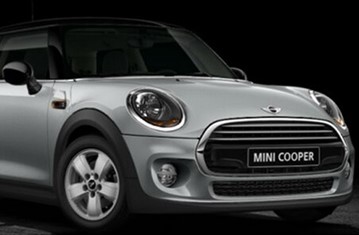
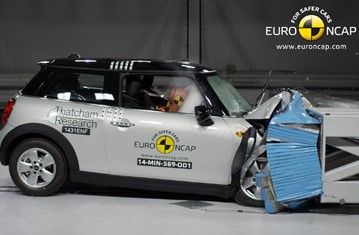
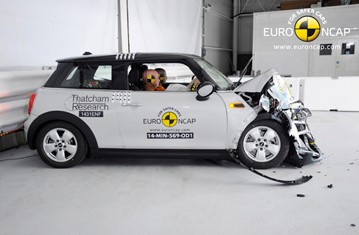
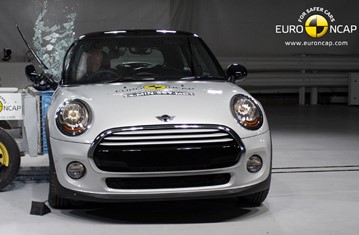

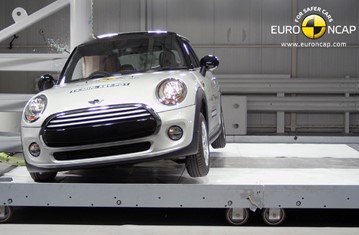
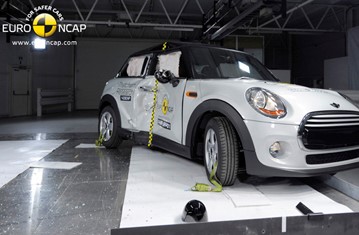




The passenger compartment remained stable in the frontal impact. Dummy readings indicated good protection of the knees and femurs of the driver and passenger. MINI showed that a similar level of protection would be provided to occupants of different sizes and to those sat in different positions, whose knees might strike the dashboard at a different location to that seen in the test. In the side barrier test, forces were transmitted to parts of the dummy which are not representative of a human body, reducing the load on the ribs. These forces resulted in the maximum penalty being applied to the chest score and the assessment being downgraded from good to marginal. Loads on the abdomen also indicated marginal protection. In the pole test, protection of the chest and abdomen was rated as adequate. Tests on the front seats and head restraints revealed good protection against whiplash injury in the event of a rear-end collision, while a geometric assessment of the rear seats indicated that the protection there would also be good. An autonomous emergency braking system is available which works at low, city-type speeds. As it is an option, it was not included in the assessment.